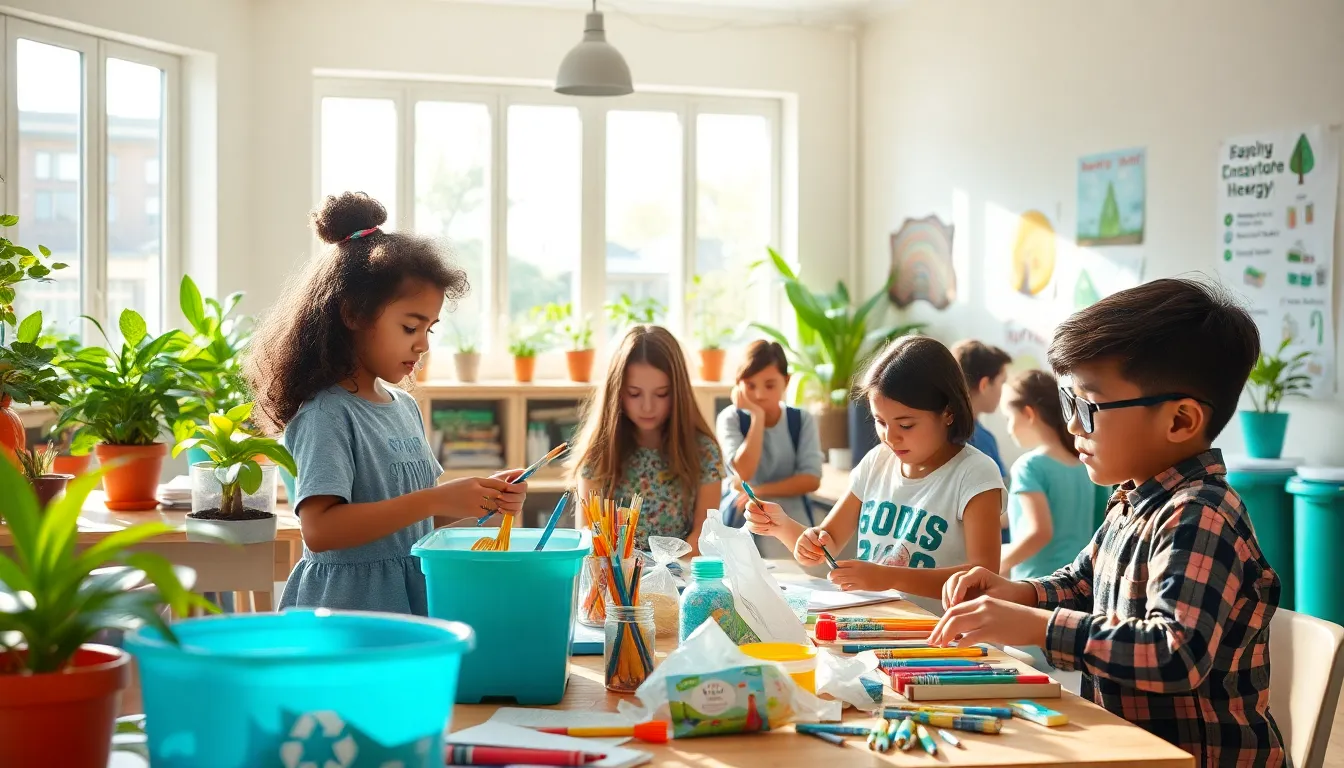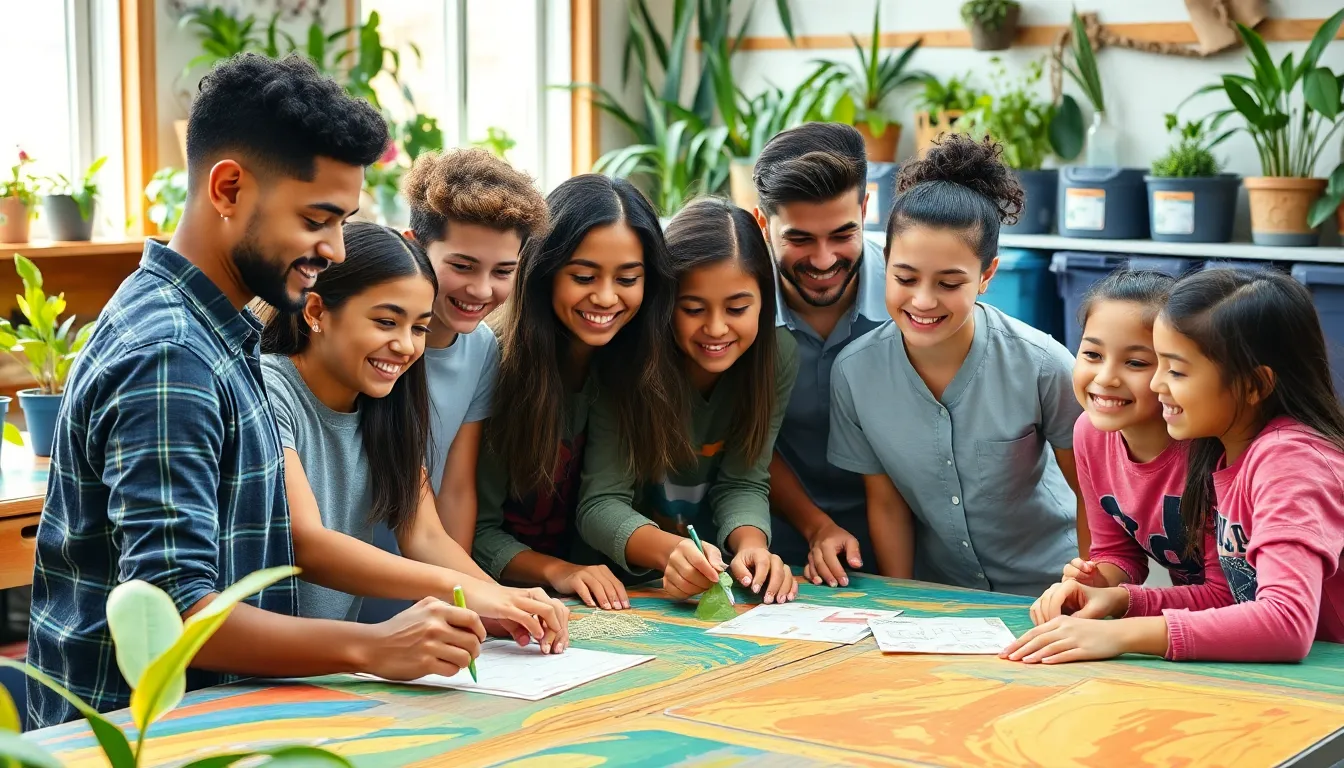In a world where plastic straws are the enemy and recycling bins are the heroes, creating an eco-friendly classroom is like throwing a party for Mother Nature. Who wouldn’t want to join the green revolution? Not only does it save the planet, but it also teaches students the importance of sustainability while making learning more engaging and fun.
Table of Contents
ToggleUnderstanding Eco-Friendly Classrooms
Eco-friendly classrooms promote sustainability through various practices and approaches. These spaces encourage students to develop environmentally conscious behaviors while enhancing their educational experience.
Importance of Sustainability in Education
Sustainability in education plays a crucial role in shaping future generations. It fosters awareness about environmental issues and encourages proactive problem-solving. Incorporating sustainable practices into learning environments equips students with knowledge about conservation and resource management. Students engage in discussions about their ecological impact, making connections between academic content and real-world applications. Understanding sustainability promotes critical thinking and prepares students for future challenges related to climate change.
Benefits of Eco-Friendly Practices
Implementing eco-friendly practices in classrooms yields numerous advantages. Environmental stewardship instills responsible behaviors in students, who learn to value natural resources. Cost savings become apparent through energy-efficient technologies and reduced waste. Healthier learning environments arise from the use of non-toxic materials and improved indoor air quality. Additionally, fostering collaboration among students leads to stronger community ties through sustainability projects. Eco-friendly practices not only benefit the planet but also enhance the overall educational experience for students.
Eco-Friendly Classroom Tips

Creating an eco-friendly classroom involves implementing several sustainable practices that foster environmental awareness.
Reducing Waste
Reducing waste significantly benefits the environment. Implementing recycling bins encourages responsible disposal of waste. Choosing digital resources over printed materials minimizes paper usage. Organizing supply swaps among students helps keep items in circulation. Providing students with reusable water bottles cuts down on single-use plastics. Introducing composting programs engages learners in managing organic waste, promoting hands-on experience in sustainability.
Energy Conservation
Energy conservation plays a critical role in an eco-friendly classroom. Utilizing natural light whenever possible minimizes the need for artificial lighting. Switching to energy-efficient LED bulbs reduces electricity consumption. Encouraging the use of smart power strips prevents phantom energy drain when devices aren’t in use. Maintaining classroom temperature with energy-saving strategies, like proper insulation and thermostat settings, optimizes heating and cooling efforts. Educating students on energy conservation illustrates its importance and encourages responsible habits.
Sustainable Materials
Sustainable materials enhance the eco-friendliness of classroom resources. Selecting non-toxic art supplies ensures safer options for students. Incorporating recycled paper in projects reinforces the principles of recycling. Choosing durable furniture made from renewable resources supports long-lasting use. Integrating green school supplies, such as biodegradable binders, promotes environmentally friendly practices. Teaching students about sourcing materials responsibly cultivates an understanding of their impact on the planet.
Engaging Students in Eco-Friendly Practices
Engaging students in eco-friendly practices creates a dynamic learning environment. Active participation encourages students to appreciate sustainability.
Incorporating Environmental Education
Environmental education integrates seamlessly into various subjects. Science lessons can cover topics like ecosystems and climate change. Math classes might incorporate data analysis of energy consumption. History discussions can highlight environmental movements and their impact. Every subject offers opportunities to connect students with ecological concepts, fostering critical thinking and problem-solving skills. Students gain a holistic understanding of their role within the environment.
Student-Led Initiatives
Student-led initiatives empower individuals to take charge of sustainability efforts. Establishing eco-clubs allows students to brainstorm and implement their ideas. Organizing events like clean-up days fosters teamwork and camaraderie. Students can initiate recycling programs that encourage participation from the entire school. Promoting a school garden not only provides hands-on learning experiences but also enhances biodiversity. Engaging in these initiatives cultivates a sense of responsibility and pride in contributing to eco-friendly practices.
Creating a Green Learning Environment
Creating a sustainable classroom involves strategic design choices and engaging outdoor learning experiences. These elements foster eco-friendliness and enhance the educational atmosphere.
Classroom Design
Classroom design can significantly impact sustainability efforts. Consider incorporating furniture made from recycled materials, which reduces waste and promotes responsible sourcing. Natural light enhances learning, so use large windows and light-colored walls to reflect brightness. Indoor plants improve air quality, making the environment healthier for students. Integrating technology, such as smartboards, minimizes paper usage. Space organization encourages collaboration, allowing students to easily share resources and ideas. Décor featuring eco-friendly materials reinforces the message of sustainability.
Outdoor Learning Spaces
Outdoor spaces provide unique opportunities for hands-on learning. School gardens enable students to engage with nature while learning about ecosystems and food sources. A green outdoor classroom offers a setting for environmental science lessons steeped in real-world applications. Using native plants in landscaping supports biodiversity and provides habitats for local wildlife. Outdoor seating areas constructed from sustainable materials create inviting spaces for creativity. Field trips to local parks or nature reserves foster a deeper understanding of ecological stewardship. Emphasizing outdoor learning builds a strong connection to the environment.
Creating an eco-friendly classroom isn’t just a trend; it’s a vital step toward nurturing responsible future citizens. By integrating sustainable practices into daily routines, educators can inspire students to embrace environmental stewardship. These efforts lead to healthier learning environments and foster a sense of community among students.
As schools adopt eco-friendly initiatives, they not only contribute positively to the planet but also enhance the educational experience. Engaging students in hands-on activities and discussions about sustainability makes learning more relevant and impactful. Ultimately, the journey toward an eco-friendly classroom cultivates a generation that values and protects the environment.


